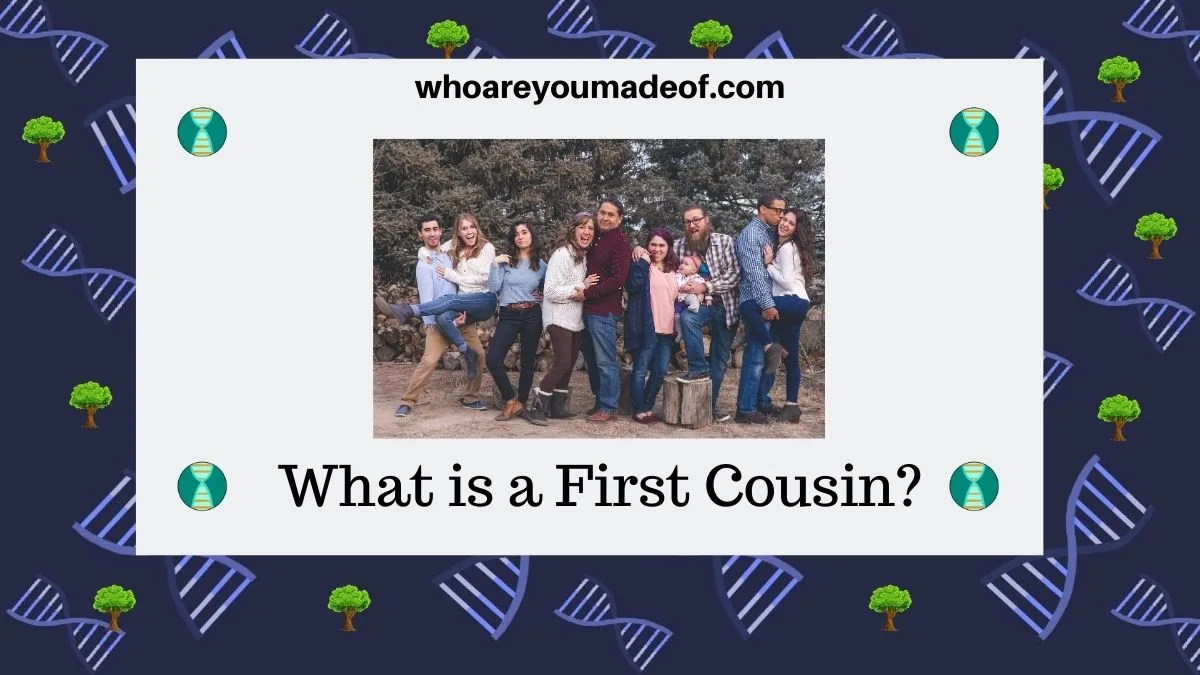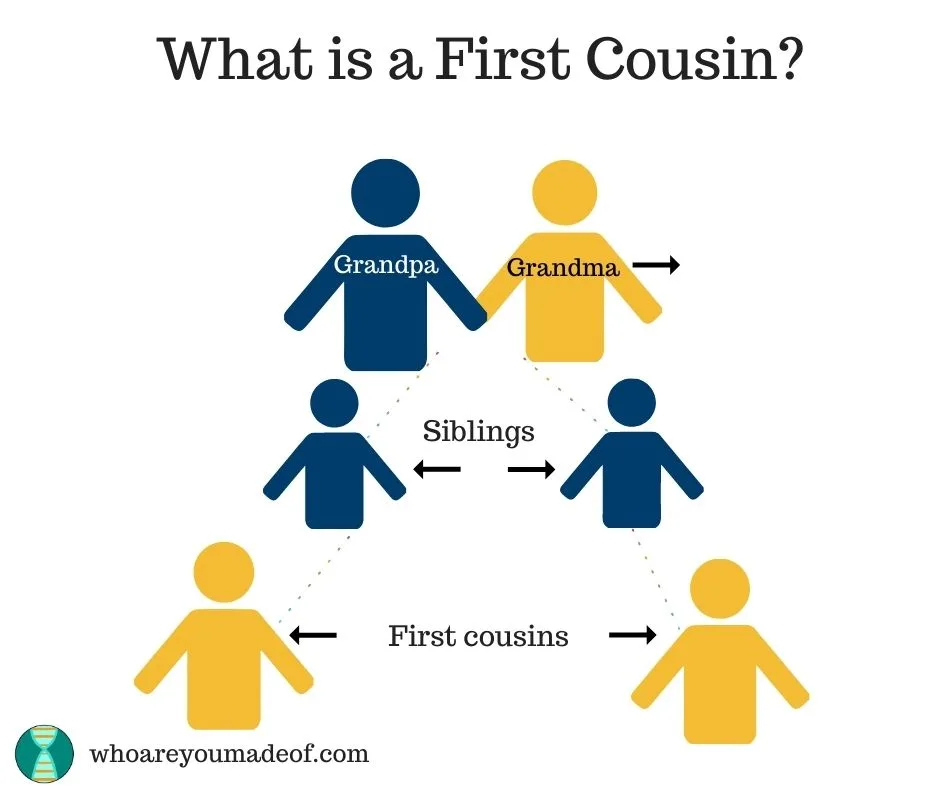Do you want to know what a first cousin is? In this post, find the definition of first cousin and exactly how a first cousin is related to you.
You will also find out:
- How many 1st cousins the average person has
- How closely related first cousins are
- The difference between a first cousin and a first-cousin once-removed
- And much more about first cousins!
I grew up knowing my first cousins who were close in age to my siblings and I. At family gatherings like Christmas and Thanksgiving, my cousins were like old friends that I only got to see a few times each year.

In most families, 1st cousins are our first introduction to our closest extended family. These relationships often last well into adulthood and can help a family’s sense of unity last generations.
I hope that this article helps you learn all that you want to know about these important members of our family.
What is a first cousin?
A first first cousin is someone who is the child of one one’s aunt or uncle and is descended from shared grandparents as the most recent common ancestors. First cousins can share one or two grandparents in common.
In other words, if you have aunts and uncles, their children are your 1st cousins. You share all of the ancestors of your grandmother and grandfather with them, which means that you share half of your family tree, or 50% of your overall ancestry, in common.
All of the children of your full or half-aunts or uncles are your first cousins. Most people simply call a first cousin a “cousin”, without specifying the exact type of cousin that they are to us.
So, when someone mentions a “cousin” it is normal to assume that they are referring to a first cousin. In large extended families where many generations of cousins are close, the word “cousin” could refer to any cousin type, however.
What is a half-first cousin?
When you only share one grandparent with the children of your aunt or uncle, such as is the case when your aunt or uncle is a half-sibling of your parent, their children are your first cousins. These cousins are often referred to as half cousins.
Even though half-first cousins share one grandparent instead of two, they are still related to us as first cousins. Their spot on the family tree is the same, whether they are full or half-first cousins.
When it comes to half-first cousins, we should note that we only share 25% of our ancestors with them. This is because our half-first cousin is related to us through only one grandparent, meaning that they have 1/4 of their family tree in common with us.
How many generations back to the common ancestor of first cousins?
The most recent common ancestor of first cousins is grandparents, who are located two generations back in the family tree.
The chart below illustrates the relationship between first cousins . The top figures are “Grandpa and Grandma”:

Grandpa and Grandma had two children, the siblings in the chart. The siblings each had a child, and those children are the 1st cousins at the bottom.
If we start at one of the first cousins and count generations back to the grandparents, we will notice that the common ancestor is two generations back.
Are first cousins considered close family?
Yes, first cousins are considered close relatives. A close relative is a relative that is between 2-4 degrees of separation, and first cousins are exactly four degrees of separation apart from each other.
To count degrees of separation, we start with one relative and count up the generations to the most recent common ancestor, which in the case of 1st cousins is the grandparents.
Then, we count down to the first cousin. Since it is two degrees (or generations) up to the grandparents and two degrees down to the first cousin, we can say that there is four degrees of separation, or consanguinity, between first cousins.
First cousins also share a lot of genetic material, also referred to as DNA. This is because their parents are siblings and they share a substantial percentage of their ancestry.
What is the difference between a first cousin and a first cousin once-removed?
The child of one’s first cousin is a first cousin once-removed. This is because the child of a 1st cousin is one generation further removed from the shared ancestors.
In other words, if one cousin is the grandchild of the most recent common ancestors and the other relative is the great-grandchild, these relatives are first cousins once-removed.
Read more: What is a Cousin Once-Removed?
How many first cousins does the average person have?
The average person can expect to have about six first cousins. This is based on the average birth rate of about 2.4 children per per woman.
If each woman has two children and her children each have two children, her grandchildren will have about six 1st cousins. This is in a “perfect” scenario, which we know is not possible.
After all, how can a woman have 2.4 children?
The exact number of first cousins that you can have will depend on the number of siblings that your parents have. If your grandparents had lots of children, then you likely have more first cousins than the average person.
My mother came from a really big family and my father came from a small one. On my dad’s side of the family, I only have one cousin.
On my mom’s side of the family, I have about fifteen first cousin cousins! In fact, I may have miscounted because I have so many and I don’t know all of them very well because of a large age difference.
(Edited to add: I actually have sixteen first cousins. I learned about a new first cousin through DNA testing.)
Are first cousins blood related?
Yes, first cousins are “blood related” and share a substantial portion of their DNA with one another.
Can first cousins get married?
In most places, it is generally considered taboo for first cousins to marry. Even though the practice is generally frowned upon in the United States, it remains legal in about half of US states.
Even though genetic problems are still unlikely among children born to first cousins, the risk of issues does increase. This may be why many countries around the world have discouraged first cousin marriage through legal, cultural, and religious means.
Prior to modern times, it was much more common for first cousins to marry. Geographical limitations means that people had less variety to choose from for potential mates, which means that there has been a considerable amount of marriage between first cousins.
In addition, marriage between first cousins also gave families advantages. Economic and political power could be kept in the family if cousins married, which might explain some famous first cousin marriages.
Most of us can look in our family trees and find evidence of first cousin marriage. In my own family tree, I only have to go back five generations to one set of great-great-great grandparents.
They were first cousins from England. The family story goes that they struggled in their community to have their marriage accepted and thus immigrated to the United States.
Famous first cousin marriages
First cousin marriage is not just something that we see in the family tree of commoners like us. The revered Queen Victoria who ruled the United Kingdom for 63 years during the 19th century married her first cousin, Prince Albert.
Their common ancestor was their German-born grandfather, Francis, Duke of Saxe-Coburg-Saalfeld.
We can even find instances of marriage between double-first cousins. Alfonso XI of Castile (b. 1291) married his double-first cousin with whom he shared all four grandparents, Maria of Portugal.
However, marriage between double-first cousins is probably not such a great idea, since they share as much DNA as half-siblings. The closer genetic relationship of double-first cousins could potentially cause more problems than a typical first cousin marriage.
Conclusion
I hope that this post has helped you understand everything that you need to know about first cousins, including how many first cousins you might have and how closely these relatives are related to you.
Do you have a lot of first cousins? Be sure to write a comment in the discussion below with the number of first cousins that you have!
If you have any questions about something that you read in this post, I would love it if you joined us in the discussion below.
Thanks for stopping by!

Nicole
Wednesday 24th of January 2024
I have 93 first cousins. My dad is one of 8 and my mama was one one of 13.
Juan Manuel Escobar
Sunday 12th of November 2023
Los primos hermanos son solamente hijos de nuestros tíos y tías
Mercedes
Friday 17th of November 2023
Definitivamente! Gracias por su comentario. Sinceramente, Mercedes
kane
Saturday 13th of November 2021
I have 85 first cousins on both my parents combined is that some sort of record?
OzWaz
Saturday 3rd of July 2021
You really don't know generics do you!
This statement "which means that you share half of your family tree in common." is only accurate if it is a social construct tree. So for cousins this is not accurate if it means 'genetic' for no other reason that meiosis cell division is NEVER 50/50.